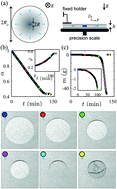Drying-induced stresses before solidification in colloidal dispersions: in situ measurements†
Abstract
We first report an original setup that enables continuous measurements of stresses induced by the drying of confined drops of complex fluids. This setup is mainly based on a precision scale working with an electromagnetic force compensation technique that provides accurate measurements of forces, while allowing simultaneously controlled evaporation rates, in situ microscopic observations, and thus quantitative estimates of normal stresses. We then performed an extensive study of the drying of a charged colloidal dispersion using this setup. Stress measurements clearly show the emergence of large tensile stresses during drying, well-before the solidification stage evidenced by the invasion of the porous colloidal material by air. Combined measurements of solid deformation and concentration profiles (particle tracking, Raman micro-spectroscopy) help us to demonstrate that these stresses are due to the formation of a solid at a low volume fraction, which further undergoes drying-induced shear deformations up to the colloid close-packing, as also supported by large deformation poroelastic modeling. Above all, our results highlight the importance of repulsive colloidal interactions in the build-up of mechanical stresses during drying.



 Please wait while we load your content...
Please wait while we load your content...